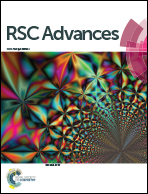The effect of modified AlN on the thermal conductivity, mechanical and thermal properties of AlN/polystyrene composites
Abstract
Modified aluminum nitride particle/polystyrene (AlN/PS) composite was prepared by a powder processing technique. The thermal conductivities, dielectric and thermal properties of composites with different mass fraction of modified AlN were investigated. Compared to the pure PS, the thermally conductive properties of AlN/PS composites improved from 0.189 W (m−1 K−1) to 0.418 W (m−1 K−1) when the content of AlN was 25 wt%. The thermal stability of the AlN/PS composite was improved with the increasing addition of AlN. The dielectric constant and dielectric loss of the 25 wt% AlN/PS composite was 3.58 and 0.0036 at 106 Hz, respectively. The dielectric constant of the AlN/PS composite showed a very small variation with the range of the frequency from 102 Hz to 106 Hz. The tensile strengths of the AlN/PS composite increased with increasing filler content when it was no more than 5 wt%, and then decreased with the further increase of the filler content, whereas the elongations at break showed the similar trends. SEM analysis showed that AlN could pack tightly, and thermally conductive AlN–AlN channels could be generated with further addition of AlN. The thermal conductivity of the AlN/PS composite with the increase of AlN content tended to be higher at higher temperatures. The thermal conductivity of the AlN/PS composites at the same AlN content tended to be higher at higher temperatures. Several theoretical models were used in comparison with experimental data of the thermal conduction of the composites.



 Please wait while we load your content...
Please wait while we load your content...